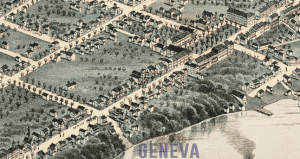Main Street Improvement Association, Part 2
By John Marks, Curator
In April I wrote about the Main Street Improvement Association. Their first project was to transform the village square into a groomed park, which it remains today.
A letter to the June 25, 1875 Geneva Daily Gazette opposed the park changes [original italics].
I notice in your paper frequent puffs in praise of the Society for the Improvement of Main street, and I for one…protest against it. As to the park which they think they have improved very much by their windings, &c., why, my dear sir, the trees they have destroyed are worth more than all the improvements so-called are worth. The children enjoyed themselves much in playing and running around, but by order – “Keep off the Grass,” are deprived of that healthful priviledge [sic].
Additional plans from the 1875 landscape engineer’s report included “a terrace on Colt’s Hill and another on Hamilton Street, facing the lake; a park treatment of the lake-side property of the College, embracing a double terrace, a ramble, an aquarium and two bath houses; an esplanade at the Mile Point end of the street with site for a soldiers’ monument or statue; [and] a picturesque treatment of Mile Point bluff.”
An 1873 bird’s-eye view of Geneva shows Hamilton Street on the left and Washington Street on the right, both going down to the lakefront. The plans called for beautifying those sections with trees and plants.
In 1877, the Main Street Improvement Association changed its name to the Village Improvement Association, in hopes of inspiring other neighborhoods to join them. However, they still focused their efforts on South Main Street. Three years after the name change their annual report in the Geneva Gazette noted there was no new support “from other parts of the village.”
An 1880 newspaper article noted the group was planting “magnolias and other trees” along Hamilton Terrace. Later that year the Gazette printed the association’s annual report, the last one to appear. The report began by regretting that no new projects had begun nor was progress made on old ones due to lack of funds. It noted that a future project from the 1875 plan was being blocked by Hobart College.
The carrying out of the beautiful design which the Association had obtained at considerable expense for the improvement and adornment of the bank in front of Hobart College, seems to be thwarted by the threatened appropriation of the bank for building purposes. [The College considered building housing for professors, but that section remains open.] This would be a great disappointment to the Association as it has looked forward with eager hope to the future realization of this beautiful improvement.
The report continued with a grievance against the village. “The globes for the four gas lights placed by the Association in Pulteney Park have been repeatedly broken, and the public has for the last year been deprived of the benefit of their use. The rustic seats have also been destroyed and the iron settees have been so broken and misused…that it has been found necessary to remove them.” The report questioned the use of improving the park if village trustees weren’t going to protect it from vandals.
In May 1881 the Grand Army of the Republic (GAR) was given permission by the village trustees to use Pulteney Park for Decoration Day ceremonies. (This tradition continues in the park as Memorial Day.) The association objected, saying that the grounds would be trampled, ruining the plants and improvements. Again, they brought up the trustees’ responsibility to protect the park. A committee of trustees asked the GAR to consider moving the ceremonies to Genesee Park, but were refused.
Today, Pulteney Park is maintained by the city. In addition to Memorial Day ceremonies, there are multiple monuments for those who gave their lives in defense of their country.
This article was brought to you in part by our supporters. Be our partner in telling Geneva’s stories by becoming a Historic Geneva supporter.



John,
Another informative article. Thanks for doing the research
Thank you John.
As always very interesting to read your articles about old times in Geneva and the development of the city. Park Place seems to have improved over the centuries .